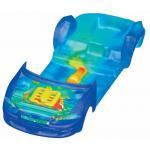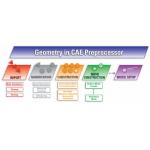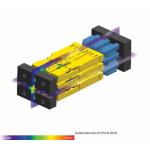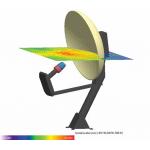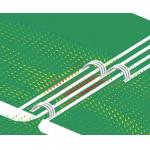October 1, 2005
By Pete Rishel and Phil Spreier
Geometric modeling is a fundamental element of computer-aided analysis. Before simulating the physical response of a shape or model, that shape must first be defined both geometrically and topologically. Developing the solutions to geometric problems is the basis of the CAD/CAM industry, but it is simply a critical starting point for an analysis software developer whose main concern is physics.
|
|
| Model building based on MCAD models is a key enabler for CFD. Image courtesy of Fluent. |
In the preprocessor of many top-flight analysis applications, you’ll find the same commercial geometric software components used in CAD/CAM applications. This makes sense on many levels. Since geometry is an advanced discipline in itself and outside the realm of expertise for CAE developers, buying this capability through proven software components is a practical and affordable alternative to internal development, which can rapidly become a cost center. And even with Herculean effort, the results of these home-grown solutions can be inferior to proven geometric technologies that are readily available, easy to integrate, and benefit from years of customer-recommended improvements.
The illustration below describes a typical breakdown of geometric functions in the preprocessor of an analysis application.
The data interoperability issues that challenge the MCAD industry today carry over into analysis. Since initial model data can come from any number of MCAD sources, it’s almost inevitable that some sort of data translation is necessary. Components such as Spatial’s InterOp translators are used to import data from standards (IGES, STEP) or proprietary formats (CATIA V5, Pro/Engineer).
|
|
|
|
“Data translators are time-sensitive technologies; they have to be up to date with the most recent versions of the various data formats to function with accuracy,” said Bob Jones, vice president of product development for Spatial. “Most CAE houses don’t have the resources to spend on keeping translators current, and don’t want to, since it’s expensive, time-intensive, and far from their core competency. As a component provider, these issues are our core competency and part of the overall value that we offer.”
Much of this imported MCAD data requires data healing or repair to ensure that the model properly meshes and can be analyzed. Different data translators offer varying levels of data repair; from completely automated repair to interactive repair tools to no data healing at all. Translators that do offer data repair capabilities offer the distinct advantage of reducing the overall time necessary to import and mesh a model.
MCAD data problems that require repair capabilities can range from simple, such as duplicate control points or surface parameterization errors, up to difficult, such as self-intersecting or missing surfaces. The most egregious errors that result in lost surfaces must be repaired using sophisticated modeling technologies, such as Advanced Covering (a Spatial 3D ACIS component). If the application does not have the tools to perform such repairs, the end-user will face lost productivity when trying to reconstruct the 3D model with missing data.
Once translated and healed, the process of modifying and optimizing the model for analysis can begin. Adding or removing tapers/drafts, fillets, small holes, etc., requires serious modeling horsepower—but the result will be a much more optimized analysis model that meets the refinement needs of the analysis engineer.
|
|
|
|
‹ ‹A 9-pin connector modeled in Remcom’s XFDTD electromagnetic solver. The model was modified to remove the external case, revealing the computed time snapshot of the electric fields on two planes. This information is used to predict coupling characteristics. Image courtesy of Remcom.
After the optimized structure of the model is defined, a surface mesh is created. If the surface mesher is appropriately configured, the result can be analyzed directly or used as input to a volumetric mesher.
Why You Should Care
So, now you know what components contribute to analysis applications; perhaps you’re wondering why you should care. One reason is cost. Components keep development costs manageable for established and start-up developers by decreasing the overhead necessary to obtain geometric functionality. Component companies like Spatial have been developing technologies for years, and buffering development costs all along that timeline. The likelihood of an independent company developing technologies as robust in a compressed period of time outside of their core expertise is highly unlikely—unless they pass the costs of rapid, custom development on to their users.
|
|
|
|
› ›A model of a common satellite dish with a planar field display that illustrates how energy is focused by the aperture toward the transceiver. Image courtesy of Remcom.
Another reason to care about components is productivity. By allowing analysis companies to focus on their core competencies—i.e., physics—they can accelerate their development schedules and advance their technologies at a faster rate, providing a better product.
Perhaps most importantly, component companies recognize the potential of CAE and are developing their technologies accordingly. By listening to customers, we identify problems that can be resolved or repetitive tasks that can be automated within the geometric aspects of the application.
“Our CAE-specific improvements manifest as functions,” said Ray Bagley, product manager for Spatial’s 3D Modeling line, “such as a highly configurable faceter that allows the user to generate optimized surface meshes; a defeaturing component that automates the labor-intensive process of recognizing and removing small features; and continual performance and healing capability improvements for our translators.”
|
|
|
|
‹ ‹The computed fields are displayed for a Lange coupler, a low-loss quadrature couple used in many microwave circuits. Analysis of such microstrip circuits can provide measures of design quality. Image courtesy of Remcom.
CAE’s industry growth stands at a staggering 12 percent, projected to 2008, according to Daratech. As the fastest-growing major market segment for many component suppliers, CAE functionality is a primary consideration. Suppliers like Spatial will be bringing more products with CAE-targeted functionality that will enhance existing and emerging software, contributing to faster, more robust, and richer applications.
“In the future, as computing power increases, the engineering community will attack ever-larger problems, requiring us to provide more extensibility and geometric capacity,” said Keith Mountain, CEO of Spatial. “To answer, we’re implementing new strategies that will accommodate these larger geometric problems, reducing the consumption of our components’ memory footprint, improving performance, and finding new technologies and services to improve the end-user experience in the CAE market.”
Phil Spreier is the product manager for Spatial Corp.’s InterOp line. Pete Rishel is the marketing communications manager for Spatial. Pete has written for high-tech industries for 10 years. He joined Spatial’s marketing group in 2001. Send your comments about this article by e-mailing by clicking here. Please reference “Geometry, EoA November 2005” in your message.
Delivering Advanced Electromagnetics
Remcom, the earliest producer of electromagnetic analysis, adopted component technology six years ago. Faced with the need to improve MCAD import capabilities as well as basic modeling functionality, it chose Spatial’s 3D ACIS Modeler and InterOp Translators to solve these issues with a minimum of development disruption.
“By integrating these components with the assistance of Spatial’s services and consulting services, we were able to quickly deliver enhanced functionality to our growing customer base,” said Bradley Flubacher, chief product engineer for Remcom. “Though the relationship may be transparent to our users, we work closely with Spatial to ensure geometric quality in our XFDTD, XGTD, and Wireless InSite products.”–P.S.
Fluent in Components Technology
A worldwide leader in computational fluid dynamics, Fluent uses modeling and data translators in its FloWizard and Gambit software. “We use components to perform critical geometric functions in our software,” said Scott Gilmore, Director of New Product Initiatives for Fluent.
“Since our customers use multiple CAD formats, data translators (InterOp) are absolutely necessary for accuracy, but we go a step further and use several other Spatial modeling products to enable repair, modification, and construction of all levels of geometry in the imported data.”–P.S.
Company Information
Dassault Systemes
Woodland Hills, CA
Fluent, Inc.
Lebanon, NH
PTC
Needham, MA
Remcom, Inc.
State College, PA
Spatial Corp.
Westminster, CO
Subscribe to our FREE magazine, FREE email newsletters or both!
About the Author
DE’s editors contribute news and new product announcements to Digital Engineering.
Press releases may be sent to them via [email protected].







